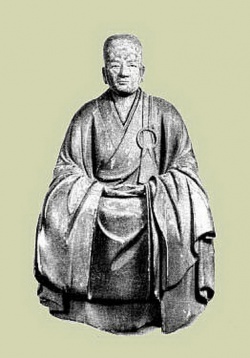Difference between revisions of "Eisai"
(Created page with "thumb|250px| <poem> Eisai [栄西] (1141–1215) Also known as Yosai. The founder of the Rinzai school of Zen in {{Wiki|Japan}}. As a ...") |
|||
| Line 4: | Line 4: | ||
[栄西] (1141–1215) | [栄西] (1141–1215) | ||
| − | Also known as [[Yosai]]. The founder of the [[Rinzai]] school of [[Zen]] in {{Wiki|Japan}}. As a youth he received the precepts and was ordained at [[Enryaku-ji]], the head [[temple]] of the [[Tendai school]] on {{Wiki|Mount Hiei}}. He traveled to {{Wiki|China}} twice, in 1168 and in 1187, and brought back the [[Zen]] teaching of the [[Lin-chi]] ( Jpn [[Rinzai]]) school. He founded a number of [[Zen]] [[temples]], including [[Shofuku-ji]] in Hakata, [[Kennin-ji]] in {{Wiki|Kyoto}}, and [[Jufuku-ji]] in {{Wiki|Kamakura}}. The opposition of the [[Tendai]] priests on {{Wiki|Mount Hiei}} made it difficult for him to propagate his teachings in {{Wiki|Kyoto}}, so he went to {{Wiki|Kamakura}}. There he founded [[Jufuku-ji]] [[temple]] with the support of [[Hojo Masako]], widow of | + | Also known as [[Yosai]]. The founder of the [[Rinzai]] school of [[Zen]] in {{Wiki|Japan}}. As a youth he received the precepts and was ordained at [[Enryaku-ji]], the head [[temple]] of the [[Tendai school]] on {{Wiki|Mount Hiei}}. He traveled to {{Wiki|China}} twice, in 1168 and in 1187, and brought back the [[Zen]] teaching of the [[Lin-chi]] ( Jpn [[Rinzai]]) school. He founded a number of [[Zen]] [[temples]], including [[Shofuku-ji]] in Hakata, [[Kennin-ji]] in {{Wiki|Kyoto}}, and [[Jufuku-ji]] in {{Wiki|Kamakura}}. The opposition of the [[Tendai]] priests on {{Wiki|Mount Hiei}} made it difficult for him to propagate his teachings in {{Wiki|Kyoto}}, so he went to {{Wiki|Kamakura}}. There he founded [[Jufuku-ji]] [[temple]] with the support of [[Wikipedia:Hōjō Masako|Hojo Masako]], widow of {{Wiki|Minamoto no Yoritomo}}, the founder of the {{Wiki|Kamakura}} {{Wiki|shogunate}}, and devoted himself to propagation. He also won the patronage of the second {{Wiki|shogun}}, {{Wiki|Minamoto no Yoriie}}, and with his support founded [[Kennin-ji]] in {{Wiki|Kyoto}}.In {{Wiki|Kyoto}} he found it necessary to compromise with the older schools; [[Kennin-ji]], for example, was not a purely [[Zen]] institution but included places for [[Tendai]] and [[True Word]] ([[Shingon]]) worship. Though not technically the first to introduce [[Zen]] ideas to {{Wiki|Japan}}, [[Eisai]] is credited with establishing Zen as an independent school. His works include The Propagation of Zen for the Protection of the Country. He also wrote Drinking Tea to Improve Health and Prolong Life, the first work on tea in {{Wiki|Japan}}. When the third {{Wiki|shogun}}, {{Wiki|Minamoto no Sanetomo}}, was ill, [[Eisai]] offered him a regimen that involved drinking tea. |
</poem> | </poem> | ||
{{R}} | {{R}} | ||
Revision as of 17:14, 4 August 2013
Eisai
[栄西] (1141–1215)
Also known as Yosai. The founder of the Rinzai school of Zen in Japan. As a youth he received the precepts and was ordained at Enryaku-ji, the head temple of the Tendai school on Mount Hiei. He traveled to China twice, in 1168 and in 1187, and brought back the Zen teaching of the Lin-chi ( Jpn Rinzai) school. He founded a number of Zen temples, including Shofuku-ji in Hakata, Kennin-ji in Kyoto, and Jufuku-ji in Kamakura. The opposition of the Tendai priests on Mount Hiei made it difficult for him to propagate his teachings in Kyoto, so he went to Kamakura. There he founded Jufuku-ji temple with the support of Hojo Masako, widow of Minamoto no Yoritomo, the founder of the Kamakura shogunate, and devoted himself to propagation. He also won the patronage of the second shogun, Minamoto no Yoriie, and with his support founded Kennin-ji in Kyoto.In Kyoto he found it necessary to compromise with the older schools; Kennin-ji, for example, was not a purely Zen institution but included places for Tendai and True Word (Shingon) worship. Though not technically the first to introduce Zen ideas to Japan, Eisai is credited with establishing Zen as an independent school. His works include The Propagation of Zen for the Protection of the Country. He also wrote Drinking Tea to Improve Health and Prolong Life, the first work on tea in Japan. When the third shogun, Minamoto no Sanetomo, was ill, Eisai offered him a regimen that involved drinking tea.
